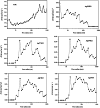Graphitic Carbon Nitride as a Platform for the Synthesis of Silver Nanoclusters
- PMID: 34817713
- PMCID: PMC8613329
- DOI: 10.1186/s11671-021-03621-z
Graphitic Carbon Nitride as a Platform for the Synthesis of Silver Nanoclusters
Abstract
Graphitic carbon nitride (CN) synthetized by the thermal polycondensation of melamine at 550 °C for 4 h was further exfoliated by heating at 500 °C for 3 h. Silver cations were adsorbed on the exfoliated graphitic carbon nitride (CNE) and then reduced by sodium borohydride forming silver nanoclusters (NCs) with a size of less than 1 nm. The NCs were located on the CNE surface and did not change the CNE properties except for its pore size distribution and thereby specific surface area (SSA). The Ag NCs were able to collect the photoinduced electrons of CNE and thus reduce their recombination with the holes. It was also documented by the increase in the CNE photocatalytic activity in terms of the degradation of antibiotic Ofloxacin. This study demonstrates the ability of CNE to serve as a platform for a simple and fast synthesis of Ag NCs without any stabilizing compounds.
Keywords: Graphitic carbon nitride; Ofloxacin; Photocatalysis; Silver nanoclusters; Synthesis.
© 2021. The Author(s).
Conflict of interest statement
The authors declare that they have no competing interests.
Figures













Similar articles
-
Comparison of Graphitic Carbon Nitrides Synthetized from Melamine and Melamine-Cyanurate Complex: Characterization and Photocatalytic Decomposition of Ofloxacin and Ampicillin.Materials (Basel). 2021 Apr 14;14(8):1967. doi: 10.3390/ma14081967. Materials (Basel). 2021. PMID: 33919916 Free PMC article.
-
Enhancement of Rhodamine B Degradation by Ag Nanoclusters-Loaded g-C₃N₄ Nanosheets.Polymers (Basel). 2018 Jun 8;10(6):633. doi: 10.3390/polym10060633. Polymers (Basel). 2018. PMID: 30966667 Free PMC article.
-
Post-Synthetic Derivatization of Graphitic Carbon Nitride with Methanesulfonyl Chloride: Synthesis, Characterization and Photocatalysis.Nanomaterials (Basel). 2020 Jan 22;10(2):193. doi: 10.3390/nano10020193. Nanomaterials (Basel). 2020. PMID: 31979003 Free PMC article.
-
Graphitic carbon nitride nanosheets as promising candidates for the detection of hazardous contaminants of environmental and biological concern in aqueous matrices.Mikrochim Acta. 2022 Oct 19;189(11):426. doi: 10.1007/s00604-022-05516-x. Mikrochim Acta. 2022. PMID: 36260130 Review.
-
Porous graphitic carbon nitride for solar photocatalytic applications.Nanoscale Horiz. 2020 May 4;5(5):765-786. doi: 10.1039/d0nh00046a. Nanoscale Horiz. 2020. PMID: 32091529 Review.
Cited by
-
Emerging and Promising Multifunctional Nanomaterial for Textile Application Based on Graphitic Carbon Nitride Heterostructure Nanocomposites.Nanomaterials (Basel). 2023 Jan 19;13(3):408. doi: 10.3390/nano13030408. Nanomaterials (Basel). 2023. PMID: 36770371 Free PMC article. Review.
References
-
- Behzad F, Naghib SM, Kouhbanani MAJ, Tabatabaei SN, Zare Y, Rhee KY. An overview of the plant-mediated green synthesis of noble metal nanoparticles for antibacterial applications. J Ind Eng Chem. 2021;94:92–104. doi: 10.1016/j.jiec.2020.12.005. - DOI
-
- Bu YY, Chen ZY, Li WB. Using electrochemical methods to study the promotion mechanism of the photoelectric conversion performance of Ag-modified mesoporous g-C3N4 heterojunction material. Appl Catal B Environ. 2014;144:622–630. doi: 10.1016/j.apcatb.2013.07.066. - DOI
Grants and funding
- 19-15199S/grantová agentura české republiky
- CZ.02.1.01/0.0/0.0/16_019/0000853/ministerstvo školství, mládeže a tělovýchovy
- LM2018098/ministerstvo školství, mládeže a tělovýchovy
- SP 2021/46/vysoká škola bánská - technická univerzita ostrava
- CZ.02.1.01/0.0/0.0/17_049/0008419/Ministerstvo Školství, Mládeže a Tělovýchovy
LinkOut - more resources
Full Text Sources
Research Materials

